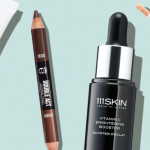WHAT CAUSES ACNE?
While the exact causes of acne have not yet been conclusively identified, there are several factors that may contribute to its development. This includes genetics, as well as hormonal fluctuations that occur during puberty, pregnancy, and before or during women’s menstrual cycles. Acne can also be triggered by stress, oil-clogging beauty products, and medication such as birth control or corticosteroids.2
CAN CERTAIN FOODS CAUSE ACNE?
There is debate as to whether eating certain types of foods can cause acne. Some studies have found that whey protein 3 or high-glycemic index food 4 items may have a positive correlation with acne development and duration. Some example of foods with a high-glycemic index include white bread, corn flakes, puffed rice, potato chips, fries, doughnuts or other pastries, sugary drinks such as milkshakes or soda, and white rice5.
WHAT IS HORMONAL ACNE?
Hormonal acne occurs in response to an imbalance in hormones, such as androgens, the most common of which is testosterone. A rise in androgen levels contributes to excess sebum (oil) production6. While a certain amount of oil is beneficial for your skin, hormonal fluctuations can cause sebum production to go into overdrive, making skin much oilier. Androgens also cause an overproduction of corneocytes (surface skin cells) at the opening of your pores. This combination of excess oil and dead skin cell build-up can create a “plug” that may block your pores. This is known as a comedone or clogged pore. Click HERE to learn more about clogged pores and the different types of acne.
OILY SKIN AND THE BACTERIA THAT “CAUSES ACNE”
When a clogged pore occurs, sebum is no longer able to flow out as it would normally. Excess sebum in oily skin therefore becomes a food source for C. acnes bacteria. While this bacteria is part of the normal skin flora, having too much of it is linked with the development of acne7. C. acnes bacteria are “anaerobic,” meaning the oxygen-deprived environment of a clogged pore makes them feel right at home. The result? The bacteria multiply and may trigger an inflammatory response. Acne blemishes such as raised papules (red bumps) or pustules (red bumps with a white head) appear. In cases of severe acne, deep cysts may form.
TYPES OF ACNE
There are two basic types of acne: Non-inflammatory and Inflammatory
The first is non-inflammatory acne which consists of clogged pores, also known as comedones.

These fall into two types:
- Blackheads (open comedones): Occur when a clogged pore is stretched open. The mixture of dead skin cells and sebum within the pore comes in contact with air, causing it to darken.
- Whiteheads (closed comedones): Occur when the clogged pore is closed, creating a white or yellow bump within the skin.
The second type of acne is inflammatory acne which consists of red, raised lesions often with a white center.

These include:
- Papules: red or pink bumps under the skin’s surface
- Pustules: large, tender bumps with a defined center filled with pus
- Nodules: large, inflamed bumps that feel firm to the touch
- Cysts: large, pus-filled lesions that look similar to boils
In adolescent acne, different types of acne often occur together and are associated with oily skin. Click HERE to discover tips on how to manage oily and acne prone skin.
SEVERE TYPES OF ACNE
Nodular and cystic acne
In severe acne, the inflammatory lesions form nodular or cystic acne (tender pus-filled lumps under the skin). This type of acne risks causing permanent scarring and should be treated by a dermatologist. Most often, dermatologists will treat these types of severe acne with prescription drug treatments including antibiotics.
ACNE WITH REDNESS
In response to the growth and multiplication of C. acnes bacteria, substances called inflammatory mediators or cytokines are released in the skin8. These are messenger molecules that cause blood vessels to dilate, causing red acne marks. If your acne is associated with generalized redness, particularly across the nose and cheeks, you may have acne rosacea. See a dermatologist for a conclusive diagnosis.
ACNE DARK SPOTS AND MARKS

Have you ever noticed that acne can leave dark spots behind after the blemish has healed? When skin inflammation occurs during a skin injury or acne breakout, your skin responds by producing extra melanin (pigment), which causes the area to darken. This is known as post-inflammatory hyperpigmentation9. Excessive sun exposure may further exacerbate this, as skin produces melanin in order to protect itself. If sun exposure cannot be avoided, it is especially important that a sunscreen is applied daily and diligently. Opt for non-comedogenic, oil free formulas such as Anthelios Clear Skin SPF 60 which is suitable for acne-prone skin and won’t cause breakouts.









